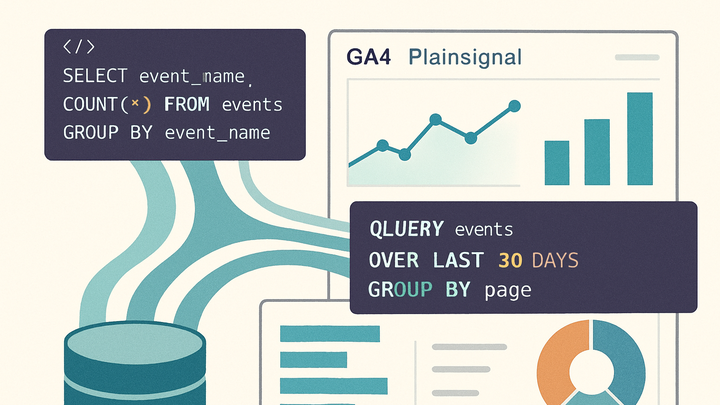Published on 2025-06-22T04:43:59Z
What Is a Query in Analytics? Examples for PlainSignal and GA4
In analytics, a query is a request sent to a database or analytics engine to retrieve, filter, and aggregate data based on defined criteria. Queries power everything from simple dashboard metrics to complex cohort analyses. They can be executed via SQL against a data warehouse, through a REST API call, or interactively within a UI like GA4 Explorations. Cookie-free tools such as PlainSignal also expose query endpoints, letting you fetch event counts without relying on third-party cookies. Well-crafted queries ensure you get accurate, performant insights and drive data-informed decisions across marketing, product, and executive teams.
Query
A query in analytics extracts, filters, and aggregates data via SQL, APIs, or UI tools to generate actionable insights.
Definition and Purpose of a Query in Analytics
This section defines what a query is in analytics and why it’s fundamental for uncovering insights. Queries allow you to extract specific data subsets, apply filters, and feed results into reports and dashboards.
-
Data retrieval
Extracts raw data from databases or analytics engines based on specified criteria.
-
Sql queries
Use SQL to directly retrieve rows from relational databases or data warehouses.
-
Api requests
Fetch data programmatically via analytics APIs like the GA4 Reporting API.
-
-
Filtering and segmentation
Refines datasets by applying conditions to include or exclude certain data points.
-
Dimension filters
Limit results based on attributes like country, device, or user demographics.
-
Metric conditions
Apply numerical thresholds or ranges, such as sessions > 1000 or bounce rate < 50%.
-
-
Reporting and visualization
Feeds query results into dashboards, charts, and automated reports to visualize insights.
-
Dashboards
Dynamic, interactive displays in tools like Google Data Studio fed by query outputs.
-
Automated reports
Scheduled query runs that generate periodic summaries via email or Slack integration.
-
Query Examples in SaaS Analytics Tools
Hands-on examples showing how queries are implemented in PlainSignal (cookie-free analytics) and Google Analytics 4, including code snippets and UI-based methods.
-
PlainSignal api query
PlainSignal uses a lightweight, cookie-free snippet to collect data and provides a REST API for querying metrics.
-
Tracking code
<link rel="preconnect" href="//eu.plainsignal.com/" crossorigin /> <script defer data-do="yourwebsitedomain.com" data-id="0GQV1xmtzQQ" data-api="//eu.plainsignal.com" src="//cdn.plainsignal.com/plainsignal-min.js"></script> -
Rest api query
bash curl 'https://eu.plainsignal.com/api/v1/events?start=2025-06-01&end=2025-06-22&metric=sessions'Fetches the number of sessions between specified dates.
-
-
Google analytics 4 query
GA4 allows you to query data via its UI Explorations or the Data API to retrieve custom reports.
-
GA4 ui explorations
Drag and drop dimensions and metrics in the GA4 interface to build ad-hoc queries and visualizations.
-
Data api request
bash POST https://analyticsdata.googleapis.com/v1beta/properties/PROPERTY_ID:runReport { "dateRanges": [{ "startDate": "2025-06-01", "endDate": "2025-06-22" }], "metrics": [{ "name": "activeUsers" }], "dimensions": [{ "name": "country" }] }Retrieves active users by country.
-
Best Practices and Optimization
Key guidelines to ensure efficient, accurate, and secure querying processes in your analytics workflows.
-
Optimizing query performance
Strategies to reduce response times and resource usage when running queries.
-
Indexing and partitioning
Ensure databases are properly indexed and partitioned to speed up data retrieval.
-
Limit data scope
Avoid SELECT * and apply precise filters or use sampling for large datasets.
-
-
Ensuring data accuracy
Methods to validate query results and maintain data quality across analytics pipelines.
-
Consistent definitions
Use standardized naming and metric definitions to avoid discrepancies.
-
Data validation checks
Implement automated tests or sanity checks to detect anomalies.
-
-
Security and governance
Practices to manage access controls and comply with data privacy regulations.
-
Access management
Use role-based permissions to restrict who can run or view queries.
-
Audit logging
Enable logging of query executions for compliance and troubleshooting.
-
